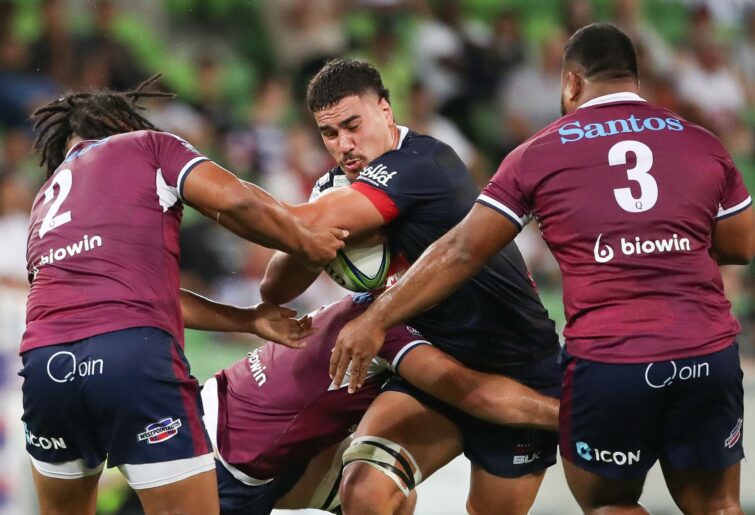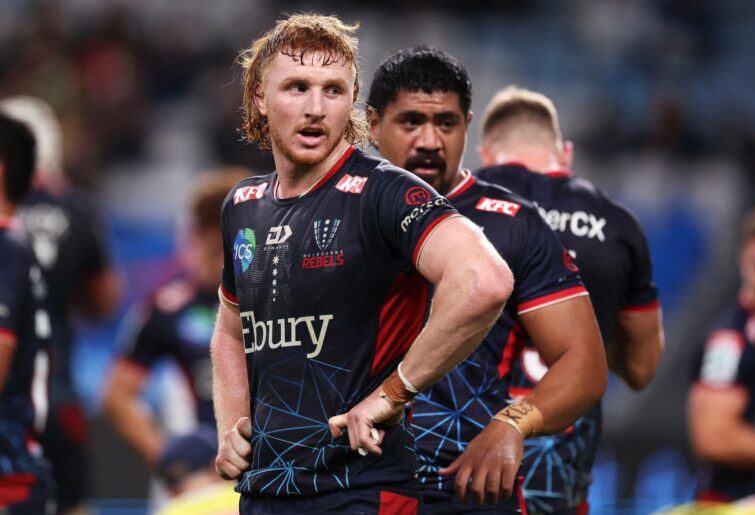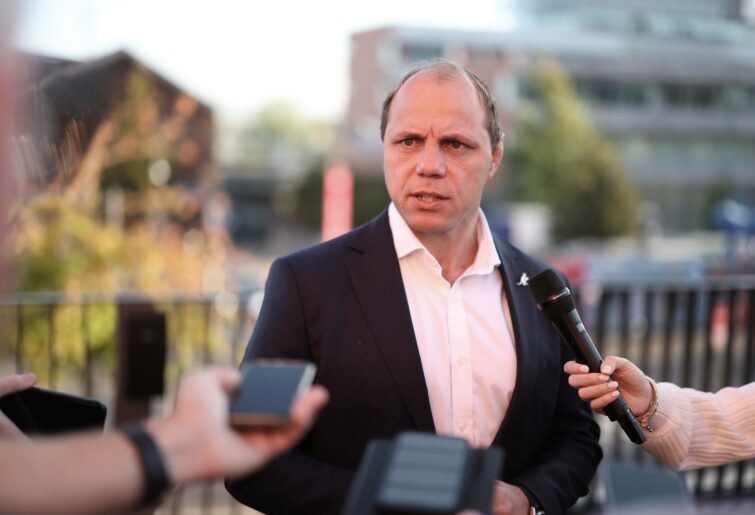One of the arguments regularly raised against the retention of a professional rugby presence in Victoria is that Melbourne is not a rugby city. Why should Rugby Australia throw good money after bad when nobody cares about the game south of the Murray?
Last week, Academy Movement founder and director, Jimmy Orange, then Rebels CEO Baden Stephenson, and Rugby Victoria President Neil Hay launched a new rugby academy at Lara Secondary College, in Melbourne’s west.
In the same week, another new academy was opened on Melbourne’s northern fringe, at Mernda Central College. This brings to eight, the total of rugby academies in Melbourne’s public school system, with five currently under Orange’s Academy Movement banner.
From nothing in 2015, that means eight schools with comprehensive rugby programs, for boys and girls, a meaningful schools competition, and a pathway for the most talented into the Rebels program.
That conveyor belt has only just got started; lock Trevor Hosea a notable early graduate, impressive Wallabies Under 20 loose forward Leafi Talataina, among others to more recently transition into a professional rugby career.

(Photo by Asanka Ratnayake/Getty Images)
Or not. Should Rugby Australia determine there is no future for the Rebels, repercussions will extend much further than the Super Rugby fixture list.
A deeper understanding of how Academy Movement works, sheds light on what is at stake. “The key to the program is focusing first on academic success. We’ve seen terrific uptick in student engagement with their schooling, staying on for longer, performing better,” says Orange.
“Rugby is an obvious motivator, but it’s important that this follows, rather than leads,” he adds.
“Not every student is going on to have a professional career, so it’s important we don’t allow them to tie their whole identity to rugby, and we give them opportunities for academic advancement.”
The model sees Orange work with each school to provide a curriculum. Included is a teacher who is also a qualified rugby coach.
It’s equal parts fun and serious business. “This is light-years removed from throwing a few cones on the ground, having the kids kick and pass a rugby ball for half an hour, and counting them as ‘rugby participants’ in an annual report,” he says.
As his business matures, Orange is able to see what works and what doesn’t, and modify his programs accordingly. “The biggest factor by far is that the students can see and feel that they are part of an integrated rugby pathway,” he explains.
“These kids are inherently aspirational. When they are able to see the real outcomes that students before them are having in rugby, meet and touch their heroes, that’s a crucial motivator for how they approach their own involvement.”
There’s more: “The provision of playing kit, for example, is vitally important. Not because it’s free gear, but because they get to wear the Rebels colours and badge. They feel as if they belong to something real, like they are the Rebels Super Rugby and Super W players of the future. And from there, future Wallabies and Wallaroos.”
It’s plainly obvious that this is a critical link between the professional and community game; something that Australian rugby has been missing for too long. But, as things stand today, it has also led Orange into a world of pain.
With education budgets stretched, Orange encountered principals who loved the concept, but who baulked at the expense. A solution was brokered with Rebels Chairman Paul Docherty, and CEO Stephenson, whereby the Rebels would subsidise some of the cost, and more schools duly signed on.
That a professional franchise should be left to fund a schools development program reflects poorly on Rugby Australia. Faced with the choice of following the New South Wales path, where backs were turned on Western Sydney, and leaving these schools open for rugby league to pick the eyes out of, or secure them for rugby, with Rugby Australia’s knowledge, the Rebels proceeded.
Orange is reluctant to criticise hard-working and well-intentioned individuals, instead pointing to system failure and a lack of vision from the game’s leaders.
“It’s like rugby development has become a slave to structure. This is the way we do things, because this is the way we’ve always done things,” he says.
“Our central and state bodies have become bogged down spreading themselves too thinly, in some cases even trying to charge schools to send development officers in. And the ones they do get into, the depth and quality of what they deliver is questionable, because there’s no integration with the rest of the game, and in some cases, little understanding of the communities they’re dealing with.”
That arrangement set Orange onto a path where, ten days ago, he attended a meeting where the appointed administrator for the Melbourne Rebels confirmed Academy Movement as an unsecured creditor. He is now owed tens of thousands of dollars for services delivered through his program, with little prospect of seeing any of it.
Perhaps the most mind-blowing aspect surrounding all of the current upheaval is how Orange, effectively doing Rugby Australia and Rugby Victoria’s job for them – developing rugby pathways on the ground – has been left substantially out of pocket for doing so.
The truth about how the Rebels accumulated such a significant amount of debt – and who at Rugby Australia knew about it and sanctioned it – will play out over time. But for now, like everyone associated with the Rebels, Orange is more anxious about what things will look like for 2025 and beyond.

Brad Wilkin of the Rebels. (Photo by Mark Kolbe/Getty Images)
“I have another two schools looking closely at the program,” he says. “There’s capacity for another five, possibly up to ten more schools after that. But not while we’re hindered by all this uncertainty. And not if we’re unable to demonstrate a direct flow through to the Rebels.”
His comments carry a stark warning. “It’s clear what will happen if we walk away. Rugby league’s approach isn’t education-based, so in my view, the kids are already disadvantaged. But they are walking into schools saying ‘rugby is dead’ and ‘we are the pathway to a junior contract with the Storm.'”
Should rugby fail to find a way to accommodate Orange and the Rebels, he has another option. Last Thursday morning he met with officials from Cricket Victoria who, unsurprisingly, were very receptive to how transferable Orange’s model is for state schools with large, cricket-loving, migrant enrolments.
“Going down that path would be so much easier for me. There’s so much more money available in cricket, it’s way easier to find coaches, and there’s a much broader demographic.”
With his Hawke’s Bay blood running thick, it will take a lot to prise Orange out of rugby. But individuals like him, and the game itself, can only sustain so many hammer blows.
On his way to the offices of Cricket Victoria, Orange met briefly with Rugby Australia CEO Phil Waugh. With so many competing priorities no one envies Waugh’s task. Friday’s announcement of an increase in funding to women’s rugby of $3 million was both welcome and necessary.

Rugby Australia CEO Phil Waugh speaks to the media. (Photo by Chris Hyde/Getty Images)
But Rugby Australia’s forward revenue streams remain uncertain. It can’t finalise a new broadcast deal without knowing how many teams it will have and what competition they will play in. On the other hand, it doesn’t know how many teams it can afford to have without knowing the quantum of its new broadcast deal.
When it comes to Orange and to the Rebels, there is a sense of Waugh being in a race against time. If the Rebels are to be cast adrift (and there are many within Rugby Australia and New South Wales and Queensland rugby for whom this is a welcome fait accompli), it would be best done before Waugh is forced to release the report commissioned into Australia’s World Cup debacle.
Setting a multimillion-dollar budget blowout, including the best part of a million dollars spent on psychologists, against what Orange could deliver for rugby with just a fraction of that money, would be an appalling indictment on Rugby Australia.
There is also the matter of a Rebels team demonstrably stronger and more advanced than at any stage of their history. As such as there can ever be a ‘friendly draw’ in Super Rugby, the Rebels have one, and they are eminently capable of ending the first month of the competition near the top of the table.
It says everything about Australian rugby that, if that were to happen, instead of being a cause for celebration, it would instead be a source of acute embarrassment.
Note: Anyone wishing to make a contribution to Academy Movement can do so by contacting admin@academymovement.education































































































